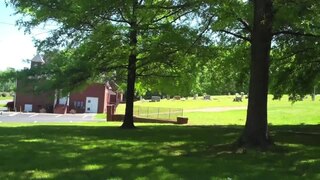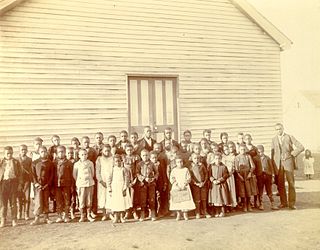
The Rosenwald School project built more than 5,000 schools, shops, and teacher homes in the United States primarily for the education of African-American children in the South during the early 20th century. The project was the product of the partnership of Julius Rosenwald, a Jewish-American clothier who became part-owner and president of Sears, Roebuck and Company and the African-American leader, educator, and philanthropist Booker T. Washington, who was president of the Tuskegee Institute.

Durham's Chapel School, also known as Durham's Chapel Rosenwald School, is a former school for African-American children located in Gallatin, Tennessee, that is listed on the National Register of Historic Places.

The Hope Rosenwald School, also known as Hope School, is a former school at 1971 Hope Station Road near Pomaria, South Carolina. As a Rosenwald School, it served rural African-American children in the early 20th century.

The Emory School, also known as the Tunstall School, is a historic Rosenwald School building in rural Hale County, Alabama, United States. It was built in 1915 to the designs of W.A. Hazel to serve the local African American community. The money to build the school was provided by the Julius Rosenwald Fund. The school was listed on the National Register of Historic Places on February 20, 1998, as a part of The Rosenwald School Building Fund and Associated Buildings Multiple Property Submission.

Liberty Colored High School is a former high school for African-American students in Liberty, South Carolina during the period of racial segregation. It originally was called Liberty Colored Junior High School. The building is now a community center known as the Rosewood Center. It is at East Main Street and Rosewood Street in Liberty. The school was built in 1937 on the site of a Rosenwald school that had burned down.

Cadentown School in Lexington, Kentucky was a primary public school for black children in the segregated Fayette County Public Schools from about 1879 to 1922. The building that originally housed Cadentown School, located at 705 Caden Lane, is no longer extant. However, the Rosenwald Fund School is listed on the National Register of Historic Places in Fayette County.

The Chicot County Training School was a historic school building at the corner of Hazel and North School Streets in Dermott, Arkansas. The single story H-shaped building was built in 1929 with funding support from the Rosenwald Fund, a major philanthropic effort to improve educational opportunities for African-Americans. The school was preceded by Dermott Baptist Industrial School, co-founded by Isaac George Bailey, and then Morris Booker High School and Memorial College. It was succeeded by Morris Booker Memorial College. The building was listed on the National Register of Historic Places in 2004. The school building collapsed and burned after being abandoned. It was delisted from the National Register in 2022.

Mt. Zion Rosenwald School, also known as Mt. Zion-Rosenwald Colored School, is a historic Rosenwald School building located near Florence, Florence County, South Carolina. It was built in 1925, and is a rectangular frame building with tall exterior windows. It is a "two or three teacher" school building. Construction of the project was funded in part by the Julius Rosenwald Fund, which helped build more than 5,300 black school buildings across the south from 1917 to 1932.

The Catawba Rosenwald School is a historic school building at 3071 South Anderson Road United States Route 21) in Catawba, South Carolina. It is a single-story wood-frame structure, built in 1924–25 with support from the Rosenwald Fund, to one of the fund's architectural plans. It served as a school for the area's African-American population from then until its closure in 1956. In 1960 the vacant building was moved within the same property to accommodate the widening of South Anderson Road. It is one of two surviving Rosenwald schools in York County. It is owned by the Rock Hill School District.

The Oak Grove Rosenwald School is a historic school building on Oak Grove Road in Oak Grove, a small settlement in southeastern Sevier County, Arkansas. It is a single-story wood-frame structure, built in 1926 with financial assistance from the Rosenwald Fund. It has two classrooms, and is based on a standard plan developed by Samuel Smith, an agent for the Rosenwald Fund, for this type of small community school. It was probably used for the education of local African Americans until the state's schools were integrated, and is the only surviving Rosenwald school in the county.

Reid's Grove School is a historic Rosenwald school located near Gatesville, Gates County, North Carolina. It was built in 1927, and is a one-story, side-gable frame school with a prominent projecting single-bay gabled wing. It was one of seven schools in the county financed and constructed with the assistance of the Rosenwald Fund for the education of African-American children. It replaced an earlier school built in the 1880s. The building ceased its function as a school in 1951.

Harnett County Training School, also known as Harnett High School, is a historic school complex for African-American students located at Dunn, Harnett County, North Carolina. The complex was built between 1922 and 1956, and consists of one two-story and five single-story brick buildings. They include a gable front combined Gymnasium/Auditorium (1948); the two-story, 14 teacher, flat-roofed, Colonial Revival-style Rosenwald-funded Harnett County Training School (1922); a detached brick boiler room (1950); two, one-story, flat-roofed Library and Office Building and Cafeteria buildings (1956); and a one-story, flat-roofed Rosenwald-funded classroom annex added in 1927, now designated the Education Building.

Lee County Training School, also known as the W. B. Wicker School, is a historic school building located at Sanford, Lee County, North Carolina. It is a one-story brick building dating to 1927 with additions in 1934 and 1949. The building is characterized by large windows alternating with pilasters and was built by contactor A.L. “Link” Boykin, a leading member of Sanford’s black community. Construction funds were provided in part by the Rosenwald Fund, conceived in the 1910s by Southern black leader and educator Booker T. Washington. The Rosenwald schools were built across the south for black Americans in the early 20th century. It served as Sanford and Lee County's African American high school until it was decommissioned as a high school in 1969. Until the year 2019, classes for grade school were last held at the school in the late 1980s. It was listed on the National Register of Historic Places in 2000.
The Arcadia Colored High School was a high school for African-American students in Arcadia, Louisiana, United States. It was originally known as Bienville Parish Training School and was later known as Crawford High School. It eventually was a campus of 10 buildings.

The Courtland School is a historic Rosenwald school at 25499 Florence Street in Courtland, Virginia. It is a single-story clapboarded wood-frame structure, built to a standard two-teacher plan developed by the Rosenwald Fund for such buildings. It is covered by a bracketed metal gable roof, and has modest Craftsman styling. It was built in 1928, and served as a segregated school for area African-American students until 1963. It was then purchased by a community group for use as a community center.

Mays Lick Negro School is a former black school in May's Lick, Kentucky. The schoolhouse, which dates to the 1920s, has been declared a historic landmark. It was a Rosenwald School.

Eleanor Roosevelt School, also known as the Eleanor Roosevelt Vocational School for Colored Youth, Warm Springs Negro School, and the Eleanor Roosevelt Rosenwald School, which operated as a school from March 18, 1937 until 1972, was a historical Black community school located at 350 Parham Street at Leverette Hill Road in Warm Springs, Georgia. As of May 3, 2010, the school is listed on the National Register of Historic Places listings in Meriwether County, Georgia.

Lincoln Heights School was a historic six-teacher Rosenwald School. Built-in 1924, the buildings of the school are now listed with National Register of Historic Places for its significance in education of African American children across Wilkes County, North Carolina.

Washington Graded School is a historic school located in Rappahannock County, Virginia. It was constructed around 1923 as a two-teacher school. The building is a "Rosenwald School". Rosenwald schools refer to those buildings constructed for the education of African-American students, with financial support and plans provided by the Rosenwald Fund. Julius Rosenwald, a Chicago philanthropist and president of Sears, Roebuck and Company, along with Booker T. Washington, the principal of Tuskegee Institute, worked with Black communities across the south to build more than 5,000 schools for Black children. Built in 79 localities in Virginia, about half shared the Washington School two-teacher design. The Washington School, which closed in 1963, retains the early look and feel of its rural setting, and exhibits historic integrity of design, workmanship, and materials.

The Union Station School is a historic building and former segregated public school for African-American students from 1928 until 1966, located in Paducah, Kentucky. It has been listed on the National Register of Historic Places since August 19, 2011 for ethnic heritage.























